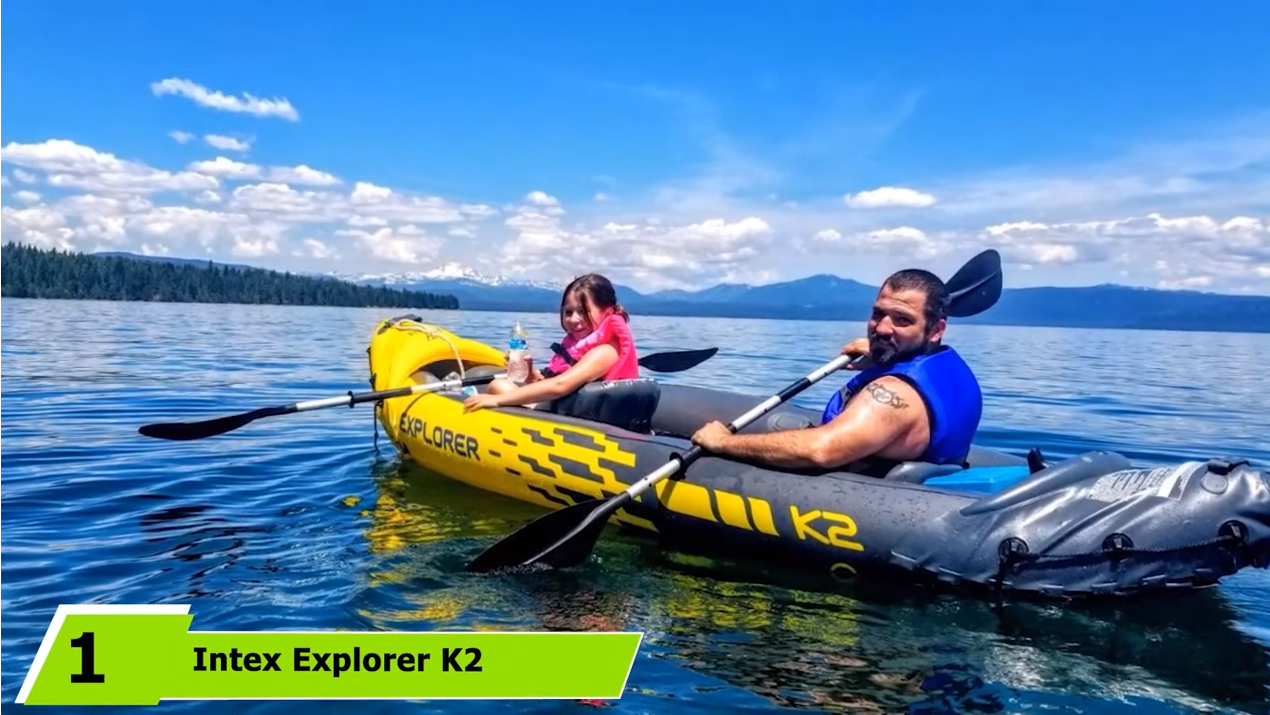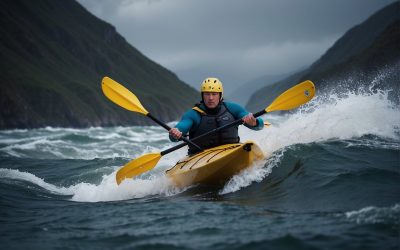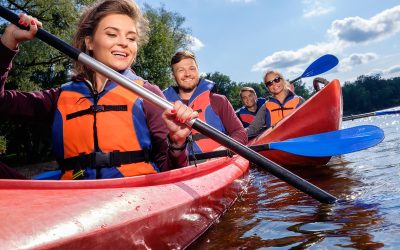Kayaking offers a unique blend of physical activity and outdoor enjoyment. It’s a low-impact exercise that works many muscle groups at once.
Kayaking can improve your strength, flexibility, and cardiovascular health while providing a fun way to explore nature.

When you paddle, you use your arms, shoulders, back, and core muscles. This full-body workout helps burn calories and build muscle.
Kayaking also allows you to enjoy fresh air and scenic views, which can boost your mood and reduce stress.
People of all ages and fitness levels can enjoy kayaking. It’s a versatile activity that can be as relaxing or challenging as you want.
Key Takeaways
- Kayaking provides a full-body workout that improves strength and cardiovascular health
- The activity offers mental health benefits by reducing stress and boosting mood
- Kayaking is suitable for various ages and fitness levels, making it an accessible form of outdoor exercise
The Physical Benefits of Kayaking
Kayaking offers a range of physical benefits that can improve overall health and fitness. It works multiple parts of the body and provides a low-impact workout suitable for many people.
Cardiovascular Fitness
Kayaking is a great way to boost heart health. Paddling makes your heart work harder to pump blood throughout your body. This helps improve cardiovascular fitness without putting too much stress on your joints.
Regular kayaking can:
- Lower blood pressure
- Reduce the risk of heart disease
- Improve circulation
To get the most out of kayaking for heart health, try to paddle at a steady pace for at least 30 minutes. Remember to breathe deeply and evenly while on the water.
Muscle Strengthening
Kayaking is an effective full-body workout. It mainly targets the upper body, but also engages core and leg muscles.
Key muscle groups worked during kayaking:
- Arms and shoulders
- Back
- Chest
- Core (abdominals and obliques)
- Legs (for stability)
Paddling provides a good workout that can increase strength and endurance over time. The resistance of the water adds extra challenge to each stroke, helping to build and tone muscles.
Flexibility and Agility Enhancement
Kayaking can improve flexibility and agility through its range of motions. The twisting and reaching involved in paddling help increase joint mobility and muscle elasticity.
Benefits for flexibility and agility:
- Increased range of motion in shoulders and back
- Better balance and coordination
- Improved core stability
Kayaking develops speed, coordination, and balance. The constant adjustments needed to stay upright and navigate the water help enhance overall body awareness and control.
Mental Health Advantages
Kayaking offers many benefits for mental health. It can help reduce stress, sharpen focus, and boost self-confidence. Let’s look at how paddling can improve your mental well-being.
Stress Reduction
Kayaking is a great way to lower stress levels. Being out on the water in nature helps calm the mind. The rhythmic motion of paddling can be very soothing.
Physical exercise like kayaking causes the brain to release endorphins. These are chemicals that make you feel good. The combination of exercise and being outdoors can really lift your mood.
Kayaking also gives you a break from daily worries. It’s hard to stress about work when you’re focused on paddling. The peaceful setting of lakes or rivers adds to the calming effect.
Improvement in Focus and Concentration
Kayaking can sharpen mental focus. Paddling requires attention to your surroundings and your movements. This trains your brain to concentrate better.
You need to watch for obstacles in the water. You also have to control your kayak and paddle. All of this takes focus and improves your ability to concentrate.
Being in nature can also clear your mind. This makes it easier to focus on tasks later. Many people find they can think more clearly after time on the water.
Boost in Self-Confidence
Learning to kayak can make you feel more confident. As you get better at paddling, you’ll feel proud of your new skills. This can boost your self-esteem.
Kayaking also lets you set and reach goals. Maybe you want to paddle a certain distance. Or learn a new kayaking skill. Meeting these goals feels great and builds confidence.
Overcoming challenges on the water can make you feel strong. You might face rough water or long trips. Getting through these builds inner strength. This can help you face other challenges in life with more confidence.
Connection with Nature
Kayaking offers a unique way to experience the outdoors. It lets people get close to nature and enjoy its positive effects on the mind and body.
Exposure to Sunlight and Fresh Air
Kayaking puts people in direct contact with sunlight and fresh air. The sun helps the body make vitamin D, which is good for bones and the immune system. Being outside in natural light can also help people sleep better at night.
Fresh air has less pollution than indoor air. It can help improve lung function and boost energy levels. Breathing in clean air while kayaking can make people feel more awake and alive.
Kayaking often happens in places with trees and plants. These give off oxygen and take in carbon dioxide. This means the air around water is often very clean and healthy to breathe.
Nature’s Impact on Psychological Well-being
Spending time in nature can reduce stress. The calm of water and natural sounds can help quiet a busy mind. This can lead to lower levels of anxiety and a more peaceful mood.
Being in nature can improve focus and attention. After time on the water, people often feel more able to concentrate on tasks. Nature can also spark creativity and help with problem-solving.
Kayaking lets people see wildlife up close. Watching animals in their natural habitat can bring joy and wonder. This connection to other living things can improve overall mental health.
Natural settings offer a break from technology and busy life. This can help reset the mind and reduce mental fatigue. Many find that time in nature helps them gain new perspectives on life.
Social and Community Benefits

Kayaking offers ways to connect with others and build relationships. It provides chances to meet new people and work together in group settings.
Opportunities for Socialization
Kayaking creates many chances to socialize. Paddling clubs and groups bring together people who share a love for the sport. These clubs often organize regular outings and events. Members can chat and bond during paddling breaks or around a campfire after a day on the water.
Kayaking trips also allow friends and family to spend quality time together. Shared adventures help strengthen bonds between people. The peaceful setting of lakes and rivers creates a relaxed atmosphere for conversation.
Teamwork and Communication Skills
Group kayaking activities build teamwork skills. Paddlers must work together to navigate rapids or plan routes. This requires clear communication and cooperation. Partners in tandem kayaks learn to sync their movements and share control.
On longer trips, kayakers divide tasks like setting up camp or preparing meals. This teaches valuable teamwork lessons that apply to other areas of life. Group members also look out for each other’s safety on the water.
Kayaking can boost self-esteem through overcoming challenges together. Achieving goals as a team creates a sense of shared accomplishment and pride.
Developing New Skills and Experiences
Kayaking offers a chance to gain valuable abilities and know-how. It pushes people to learn new things and grow in unexpected ways.
Navigational Abilities
Kayaking builds strong navigational skills. Paddlers must read maps, use compasses, and track their position on the water. They learn to spot landmarks and follow coastlines. This helps them stay on course and find their way back.
Reading water conditions is key. Kayakers study currents, tides, and wind patterns. They watch for signs of changing weather. These skills keep them safe and help plan trips.
GPS devices are useful tools. Many kayakers learn to use them for precise navigation. But they also practice old-school methods as backup. This mix of old and new makes them well-rounded navigators.
Survival Skills
Kayaking teaches important survival skills. Paddlers learn to pack the right gear for trips. They bring food, water, first aid kits, and safety equipment. Being prepared is crucial on the water.
Water rescue techniques are vital. Kayakers practice self-rescue and how to help others. They learn to right a flipped kayak and get back in. These skills can save lives in emergencies.
Weather awareness becomes second nature. Kayakers watch the sky and water for signs of storms. They know when to seek shelter and how to handle rough conditions. This knowledge applies to many outdoor activities.
Basic repairs are part of kayaking. Paddlers learn to fix small issues with their boats and gear. This self-reliance is useful both on and off the water.
Considerations for Safe Kayaking
Kayaking can be fun, but safety is key. Taking proper precautions helps ensure an enjoyable time on the water. Let’s look at some important safety tips for kayakers.
Understanding Weather and Water Conditions
Check the weather forecast before heading out. Look for wind speed and direction, as strong winds can make paddling difficult. Watch for storms or heavy rain that could cause dangerous conditions.
Pay attention to water temperature. Cold water can be risky, even on warm days. Dress for the water temp, not the air temp.
Be aware of tides and currents if kayaking in coastal areas. Strong currents can quickly pull you off course. Research local hazards like rocks, rapids, or low-head dams.
Know the signs of changing weather. Dark clouds, dropping temperatures, or increasing winds may signal an approaching storm. Have a plan to get off the water quickly if needed.
Essential Safety Gear
A well-fitting life jacket or PFD is crucial. Wear it at all times while on the water. Make sure it’s Coast Guard approved and in good condition.
Bring a whistle or sound-making device to signal for help if needed. A waterproof flashlight is important for low-light conditions.
Pack a first aid kit with basics like bandages, antiseptic wipes, and any personal medications. Keep it in a waterproof container.
Carry a paddle float and bilge pump for self-rescue. A spare paddle is smart in case you lose your main one.
Dress properly with quick-drying layers. Avoid cotton, which stays wet and cold. Consider a wetsuit or drysuit for cold water.
Basic Rescue Techniques
Learn how to do a “wet exit” if your kayak flips.
Practice this skill in shallow water with a friend nearby.
Master the T-rescue technique to help a capsized paddler.
This involves stabilizing their kayak while they climb back in.
Know how to empty a swamped kayak.
The “scoop” method works well in calm waters. In rougher conditions, learn to use a bilge pump.
Practice self-rescue using a paddle float.
This helps you get back in your kayak if you capsize when paddling alone.
Always paddle with a buddy when possible.
If you must go solo, tell someone your plans and expected return time.
Environmental Awareness and Conservation

Kayaking allows people to connect with nature and learn about local ecosystems.
This hands-on experience often leads to increased environmental awareness and a desire to protect waterways and wildlife.
Promoting Clean Waterways
Kayakers often become champions for clean waterways.
They see firsthand the impact of pollution and litter on rivers, lakes, and oceans. Many kayakers join local cleanup efforts or organize their own.
Paddling clubs frequently host “river sweep” events.
These gatherings bring people together to remove trash from waterways and shorelines.
Some kayakers take water samples to monitor pollution levels.
This citizen science helps track water quality over time.
By sharing their experiences, kayakers inspire others to care for waterways.
They post photos of beautiful scenery and wildlife encounters on social media.
Wildlife Preservation and Respect
Kayaking provides unique opportunities to observe wildlife up close.
This fosters a deep appreciation for animals and their habitats.
Responsible kayakers learn to keep a safe distance from wildlife.
They avoid disturbing nesting areas or resting spots for animals.
Many kayakers become advocates for endangered species.
They support conservation efforts and habitat protection initiatives.
Kayakers often learn to identify local plants and animals.
This knowledge helps them understand the importance of each species in the ecosystem.
Some kayaking tours focus on wildlife education.
Guides teach participants about local flora and fauna, encouraging a conservation mindset.
Frequently Asked Questions

Kayaking offers numerous physical and mental health benefits. It can aid in weight loss, muscle development, and stress reduction. Many people find kayaking to be a fun social activity with some potential risks to consider.
What are the top benefits of kayaking for physical health?
Kayaking provides a full-body workout.
It strengthens the arms, shoulders, back, and core muscles.
The activity also improves cardiovascular health and endurance.
Regular paddling can boost overall fitness levels.
Can engaging in kayaking assist in weight loss and belly fat reduction?
Yes, kayaking can help with weight loss and reducing belly fat.
It burns calories and engages core muscles.
Consistent kayaking can increase metabolism and improve body composition over time.
How does kayaking influence muscle development and body transformation?
Kayaking builds upper body and core strength.
It tones muscles in the arms, shoulders, back, and abdomen.
Regular paddling can lead to improved posture and increased muscle definition.
In what ways does kayaking contribute to mental health improvement?
Kayaking can reduce stress and anxiety.
Being on the water often has a calming effect.
The activity promotes mindfulness and can boost mood.
It provides a sense of accomplishment and connection with nature.
What are the social advantages of participating in kayaking?
Kayaking can be a great social activity.
It allows people to bond over shared experiences on the water.
Joining kayaking groups or clubs can lead to new friendships and a sense of community.
What are some potential drawbacks or risks associated with kayaking?
Kayaking carries some risks, such as the possibility of capsizing or injury from improper technique.
Exposure to sun and water can lead to sunburn or hypothermia if proper precautions aren’t taken.








